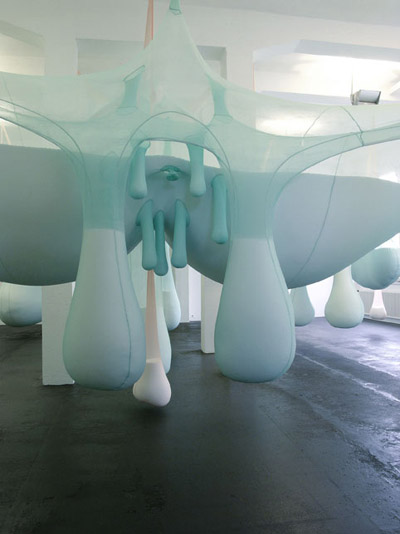 Installation view at Bob van Orsouw Gallery Zurich, 2006 Ernesto Neto how to put it up, dulcieneia! Click for English text Nach zahlreichen internationalen Einzelausstellungen (u.a. Hirshhorn Museum, Washington, Kunsthalle Basel, MOCA, Los Angeles, ICA, London) präsentiert Ernesto Neto (1964, Rio de Janeiro) sein Werk erstmals in der Galerie Bob van Orsouw. Netos Interesse gilt binären Systemen, Cybernetics, Science fiction, Entropie und Philosophie. Seine Auseinandersetzung mit skulpturalen Problemen ist unorthodox, wenn auch nicht weniger genuin. Wenn Neto über das Verhältnis von Fläche und Volumen, von Figur und Raum nachsinnt, dann denkt er an künstlerische Vorgänger genauso wie an die Feingliedrigkeit eines Spinnennetzes. Elastisch und belastbar zugleich bedeutet es eine räumliche Struktur, in der Gleichgewicht und Gravitation zu einem permanenten "equilibrium in suspense" austariert werden, ein Prinzip, das Netos skulpturalem Schaffen ebenso zugrunde liegt. Netos Ansatz, die Widerständigkeit "fester" Materialien, wie Holz, Metall oder Stein durch "weiche" Materialien zu überwinden, kann gleichfalls als Aushebelung herkömmlicher Raumkonzepte verstanden werden. Sein Einsatz textiler Materialien resultiert in einem Formenvokabular, das keine rechten Winkel und Geraden mehr kennt. Anstelle von einfach lesbaren Geometrien geben sich seine Skulpturen als labyrinthische Hohlräume, tropfenförmige Gehänge, konkave Ausformungen, zellgleiche Behausungen. Opak oder transparent werden die Textilien mit Gewürzen, Farbpigmenten, Reis, Sand oder Styroporkugeln gefüllt. Aufgrund ihrer Dehnbarkeit generieren sie ihre Formen gleichsam selbst, da sich ihre äussere Gestalt allein durch die Schwere des Inhalts bestimmt. Die Skulpturen gleichen Organismen, die in den Raum hinein wachsen, Gerüche verströmen, taktile Reize aussenden und halluzinativ in ihrer Farbwirkung sind. Ein Topos in Netos Werk ist das "nave", eine hängende, begehbare Skulptur aus dünnem Stoff, die je nach räumlicher oder topographischer Situation modifiziert wird (im Ödland von Santa Fé, Mexico realisierte Neto ein "Stella nave" unter freiem Himmel). Das "nave" umfängt den menschlichen Körper wie eine poröse Membran, die sich im Rhythmus seiner Bewegung dehnt oder zurückbildet. Der Betrachter findet sich in einer "spatial entity" wieder, in der die Zeit entschleunigt, der Raum entgrenzt ist. Schwereloses Flottieren in a "constant state of transcience" wird möglich, indem Körper und Skulptur in ein osmotisches Verhältnis zueinander treten. In der Galerie Bob van Orsouw wird Neto, basierend auf dem Konzept des "nave", eine den gesamten Raum umfassende, von der Decke hängende Skulptur realisieren, eine Art amorphe Architektur des Utopischen, in der sich das Interesse des Künstlers am wilden Wuchern einer Grossstadt wie Rio de Janeiro, Netos Geburtsort und Lebensraum, widerspiegelt. Vor dem Hintergrund dieser pulsierenden Megalopolis erinnert sein plastisches Schaffen an architektonische Experimente der Avantgarde, die urbane Zonen wie skulpturale Massen formte und damit visionäre Erlebnisräume, "Laboratorien des Körpers", schuf. Text: Birgid Uccia Ausstellungsdauer 3.6. - 22.7.2006 Öffnungszeiten Di-Fr 12 - 18 Uhr, Sa 11-16 Uhr und nach telefonischer Verabredung Galerie Bob van Orsouw Limmatstrasse 270 8005 Zürich Telefon +41 (0)44 273 11 00 Fax +41 (0)44 273 11 02 Email mail@bobvanorsouw.ch www.bobvanorsouw.ch Ernesto Neto how to put it up, dulcieneia! Following numerous international solo exhibitions (among others, at Hirshhorn Museum/Washington, Kunsthalle Basel, MOCA/Los Angeles, ICA/London) Ernesto Neto (born 1964 in Rio de Janeiro) will now for the first time present his work at the Galerie Bob van Orsouw. Neto's interest is focused on binary systems, cybernetics, science fiction, entropy and philosophy. His engagement with sculptural problems is unorthodox, if no less authentic. When Neto ponders on the relationship of plane and volume, of figure and space, he is thinking of his artistic predecessors just as much as of a filigree spider's web. Flexible and resilient at the same time, it represents a spatial structure in which balance and the force of gravity are poised in a permanent "equilibrium of suspense", a principle that is also basic to Neto's three-dimensional work. Neto's approach, which seeks to overcome "solid" materials such as wood, metal or stone via "soft" materials, can equally be understood as suspending conventional concepts of space. His use of textiles results in a formal vocabulary that no longer seems aware of right angles and straight lines. Instead of simple, readable geometries, his sculptures propose labyrinthine cavities, dropped-shaped forms, cell-like dwellings, concave shapes. The fabrics, opaque or transparent, are filled with spices, pigments, rice, sand or Styrofoam balls. Because of their extensibility, the fabrics generate their own forms, since outer dimensions are determined solely by the weight of their content. The sculptures resemble organisms that grow into the room, emit odors, send out tactile stimuli, their colors hallucinating. A topos of Neto's work is the "nave", a hanging, walk-in sculpture of thin fabric that is modified according to the spatial or topographical situation (in the barren expanse around Santa Fé, Mexico, Neto installed a "Stella nave" outdoors). The "nave" envelopes the human body like a porous membrane that, in rhythm with his movements, expands and recedes. The viewer resurfaces in a "spatial entity" in which time has slowed and space shed its limits. Weightless floating in a "constant state of transcience" becomes possible, where body and sculpture encounter each other in an osmotic relationship. In the Galerie Bob van Orsouw, Neto will realize a sculpture based on the concept of the "nave" that comprises the entire room and hangs from the ceiling, a kind of amorphous utopian architecture that mirrors the artist's interest in the unchecked sprawl of a big city like Rio de Janeiro, Neto's birthplace and habitat. Against the backdrop of this pulsating megalopolis, his three-dimensional work recalls architectural experiments of the avant-garde, which once composed urban zones like sculptural masses and thus produced venturesome, visionary spaces, "laboratories of the body". Text: Birgid Uccia Exhibition 3 June - 22 July 2006 Gallery hours Tues-Fri noon - 6 pm, Sat 11 am - 5 pm |